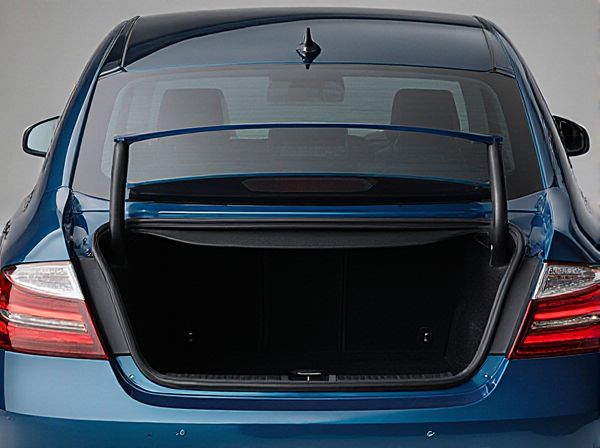
Photo illustration: Fastback vs Notchback
Fastback cars feature a continuous, sloping rear roofline that extends seamlessly to the tail, enhancing aerodynamics and sporty aesthetics. Notchback designs have a distinct, angled rear window with a clear separation between the roof and trunk, offering more trunk space and a classic silhouette. Your choice between fastback and notchback depends on whether you prioritize style and speed or practicality and traditional design.
Table of Comparison
| Feature | Fastback Trunk | Notchback Trunk |
|---|---|---|
| Design | Smooth, continuous slope from roof to trunk | Distinct, separate trunk section with clear angles |
| Aerodynamics | Improved airflow; reduced drag | Less aerodynamic due to abrupt trunk angle |
| Trunk Space | Often smaller due to sloping roof | Generally larger and more squared off |
| Rear Visibility | May be reduced by sloping rear window | Better rear visibility with upright rear window |
| Common Models | Mustang Fastback, Audi A5 Sportback | Toyota Camry, Honda Accord Sedan |
Fastback vs Notchback: Key Design Differences
Fastback designs feature a continuous slope from the roof to the rear bumper, enhancing aerodynamic efficiency and creating a sleek, sporty silhouette. Notchback models have a distinct, angular separation between the roofline and the trunk, producing a more traditional three-box shape with defined compartments for the engine, passenger area, and cargo. This design difference impacts both aesthetics and rear visibility, with fastbacks offering smoother airflow and notchbacks providing improved trunk access and rear window clarity.
Aerodynamics: Fastback and Notchback Impact
Fastback designs feature a continuous slope from the roof to the rear, creating a streamlined shape that reduces air resistance and enhances aerodynamic efficiency. Notchback styles, with their distinct trunk separation and sharper angles, tend to generate more drag due to airflow disruption behind the rear window. This aerodynamic variance results in improved fuel economy and higher top speeds for fastbacks compared to notchbacks.
Aesthetic Appeal: Which Style Stands Out?
The aesthetic appeal of fastback versus notchback styles hinges on sleekness and visual flow, with fastbacks showcasing a continuous, aerodynamic roofline that creates a sporty and modern silhouette. Notchbacks emphasize a distinct separation between the roof and trunk, offering a classic, structured profile that appeals to traditional design enthusiasts. Fastbacks often stand out for their dynamic, aggressive look, while notchbacks convey timeless elegance through clean, defined lines.
Interior Space and Practicality Comparison
Fastback models typically provide a more streamlined roofline that can reduce rear headroom and cargo space, impacting interior comfort for taller passengers and limiting luggage capacity. Notchback designs generally offer a more upright rear profile, resulting in increased rear passenger headroom and a larger, more accessible trunk area for everyday practicality. When prioritizing interior space and practicality, notchbacks often present advantages with enhanced passenger comfort and cargo versatility over fastbacks.
Performance: Handling and Efficiency
Fastbacks typically offer enhanced aerodynamics due to their sloping rear roofline, resulting in improved fuel efficiency and higher top speeds compared to notchbacks. The streamlined design reduces drag, which positively impacts handling by increasing stability at higher velocities. Notchbacks, with their more vertical rear profile, may experience slightly reduced aerodynamic efficiency but often provide a stiffer chassis, contributing to precise handling and cornering performance.
Trunk Space: Usability Differences
Fastback designs feature a sloping rear roofline that reduces vertical trunk space, limiting usability for tall or bulky items, whereas notchback models provide a distinct trunk with higher vertical clearance, optimizing storage capacity. The notchback's separate trunk compartment allows for better organization and easier access to cargo, making it more practical for frequent loading and unloading. Fastbacks often compromise rear-seat headroom and cargo flexibility to achieve aerodynamic styling, resulting in smaller usable trunk volume compared to notchbacks.
Historical Origins of Fastback and Notchback
The fastback design originated in the 1930s, characterized by a continuous, sloping roofline extending to the rear bumper, popularized by vehicles like the 1938 Lincoln Zephyr and later performance cars such as the Ford Mustang Fastback in the 1960s. In contrast, the notchback style emerged earlier, featuring a distinct three-box shape with separate compartments for engine, passengers, and cargo, exemplified by classic sedans like the 1940s Cadillac Series 61 and the 1957 Chevrolet Bel Air. The evolution of these styles reflects automotive trends favoring aerodynamics and aesthetics, with fastbacks emphasizing sleek profiles and notchbacks prioritizing traditional, angular designs.
Popular Fastback and Notchback Models
Popular fastback models like the Ford Mustang Fastback and Porsche 911 feature a distinctive sloping roofline that enhances aerodynamics and sporty aesthetics. Iconic notchback vehicles include the BMW 3 Series Sedan and Mercedes-Benz C-Class, characterized by a defined rear window and trunk separation that offers classic styling and practical trunk access. Both designs serve different automotive preferences, with fastbacks emphasizing sleek, performance-oriented looks and notchbacks focusing on traditional, functional sedans.
Price and Market Availability
Fastbacks typically command higher prices due to their sleek, aerodynamic design and limited production runs, making them less common in the used car market. Notchbacks offer more affordability and wider availability, as their traditional four-door sedan structure appeals to a broader customer base and often features more model options. Market availability for notchbacks generally exceeds that of fastbacks, especially in mid-range pricing segments and family-oriented vehicles.
Choosing Between Fastback and Notchback: Buyer’s Guide
Choosing between a fastback and notchback depends on your style preference and practical needs; fastbacks feature a sloping rear roofline for a sportier appearance and improved aerodynamics, while notchbacks offer a distinct three-box design with a separate trunk, providing more defined cargo space. Consider vehicle usage--fastbacks typically appeal to those valuing sleek aesthetics and potentially better performance, whereas notchbacks suit buyers prioritizing rear passenger headroom and trunk accessibility. Evaluate factors like fuel efficiency, resale value, and daily comfort based on these body styles to make an informed purchase decision.
 caratoz.com
caratoz.com